Abstract
The microclimate plays a crucial role in the conservation of historical cult buildings and their artifacts for future generations. In order to conserve these buildings and their artifacts, it is imperative to ensure that the microclimate is conserved. The norms and standards existing so far in Latvia do not stipulate thresholds for air parameters that would ensure a conserving microclimate for historical cult buildings. In order to identify these thresholds, the air parameters were measured simultaneously at nine measuring points within the Krimulda Church (LV) of the 13th century. The temperatures of the surfaces of the building envelope and potential condensation were calculated using the actual data of indoor and outside air. The indoor and outdoor air humidity ratio was calculated for each measurement. The conservation threshold of indoor microclimate parameters was determined by using intermittent heating on the basis of the air parameter fluctuations and calculations. The moisture vapours from the building structures were quantified in this research. The indoor humidity ratio during the warm season and the upper threshold during the heating season were determined.
1. Introduction
The microclimate is a crucial factor allowing for the preservation of buildings and the items within them. An inappropriate indoor microclimate may result in material losses or the loss of these items. There are 2604 cult buildings in Latvia which are or which contain cultural monuments of national importance. The norms and standards currently existing in Latvia regarding the preservation of the microclimate in historical cult buildings do not contain specific air parameters [1]. The standard LVS EN15759-1:2012 recognises two approaches to ensuring a microclimate for churches [2].
- Indoor climate for conservation;
- Indoor climate for thermal comfort.
This standard defines several heating system strategies for churches:
- No heating;
- Conservation heating;
- Heating for thermal comfort.
Our goal was to identify the air parameter thresholds necessary to maintain a conservational air microclimate, adhering to which reduces the risk of condensation and thereby prevents the formation of mould and other fungi.
Out of the 276 Lutheran churches in Latvia, ten date back to the 13th century and are masonry buildings. Among these, seven are single-nave churches and three are three-nave churches. According to a compilation of Latvian Lutheran church typologies, building envelopes of the 13th century churches are homogeneous and with equal U = 0.87 (W/m2K) values [3].
2. Literature Review
When reviewing the analysis of the air flow impact in historical churches in IDA-ICE 4.8 simulation software, particularly focusing on the largest vertical surfaces of the building, such as doors and windows, it becomes evident that the simulation data for such buildings do not align with the actual measurement data [4]. In the southern part of Europe (Spain, Italy, etc.) the indoor microclimate of historical churches is maintained mainly by expending energy to cool them down during the hot season. [5,6] In southern European countries [7], just like in the Baltic states [8,9], historical churches have huge air humidity fluctuations. Energy consumption for the indoor microclimate of historical churches in the Baltic states is related to the cold seasons [3,10]. Improper indoor air temperatures and relative humidity may facilitate the spread of wood-decay fungi in wooden structures [11]. One of the closest neighbouring countries to the Baltic countries is Poland, where air parameters differ from those in Latvia and align more closely with those of other European countries. Regarding historical churches in Poland, it has been observed that the indoor humidity ratio depends on the outside air humidity, and the highest humidity ratio of indoor air is reached in August, amounting to 13 g/kg [12]. In the Netherlands, the major moisture problems in historical buildings are caused by the high groundwater levels and overflowing of rivers [13]. When comparing modern churches to those from the Baroque period, specifically churches of the 17th–18th century in Malta, it has been observed that parameters of indoor air during summers are more stable in Baroque churches with larger thermal mass [14]. The 16th and 17th century churches of the Czech Republic use heating elements that are placed among the benches during the cold seasons and which are switched on for the worship, only thus ensuring local intermittent heating. These have average indoor temperatures of 16.7 °C and lowest indoor temperatures of 1.1 °C [15]. Huge differences in air parameters in one room accelerate the deterioration of materials [16]. A stable microclimate allows the life of cultural and historical heritage to be extended [17]. Thorough knowledge of the usage conditions within religious building spaces is essential to identify compatible and sustainable intervention strategies [18]. Cultural heritage is threatened by biotic attacks, moulds, and fungi, which tend to develop under certain favourable microclimatic conditions (mainly at the beginning and end of winter) [19]. Pollutants can be viewed as a significant contributor to the deterioration of construction materials used in the field, particularly in the case of heritage buildings that are part of and represent the culture of a country. These pollutants have a dual impact, affecting both the structural strength of the buildings in question and the visual aesthetics of the surroundings. Furthermore, their effects are enduring, influencing aspects such as living conditions, quality of life, tourism, economic activities, and various facets of local daily life [20]. The decay resulting from moisture, primarily due to inadequate ventilation of the hidden faces of wall plates, has been established as the most significant risk to structural stability [21].
3. Materials and Methods
3.1. The Warm Air Flow and Temperature Distribution in the Premises of the Krimulda Church and on the Surface of the External Wall
Temperature was measured with the measuring instrument HOBO 4-Channel Analogue Data Logger (UX120-006M; Onset, Bourne, MA, USA) in 30 min intervals, with a temperature measuring accuracy of ±0.1 °C. These four temperature data sensors (Figure 1, Figure 2 and Figure 3) were installed with the same reading intervals as other RH and T sensors. These temperature data sensors were installed at various heights and distance at the external northern wall, where the stove was situated, as described in Table 1 and Figure 4, Figure 5 and Figure 6.

Figure 1.
(a) HOBO 4-Channel Analogue Data Logger (UX120-006M; Onset); (b) LWIR Micro Thermal Camera Module FLIR Lepton (Teledyne FLIR, Wilsonville, OR, USA); (c) HOBO MX1104 Temp/RH/Light/Ext-Temp Kit (Onset).
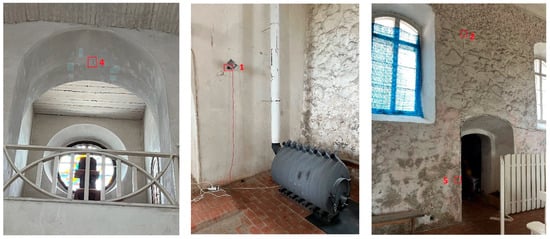
Figure 2.
Indoor measurement devices (where 1, 4, 2 and 5: numbers of measuring devices).
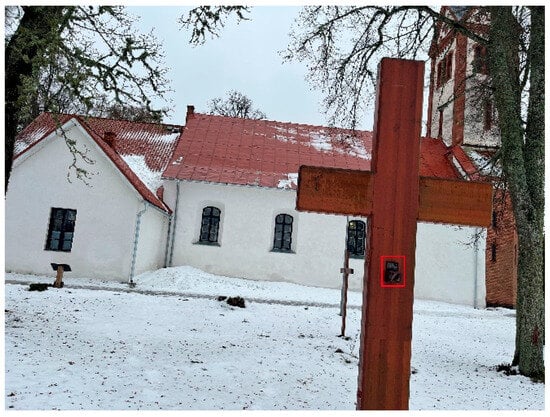
Figure 3.
No. 9 outdoor measurement device.

Table 1.
Measuring devices in the Krimulda Church.
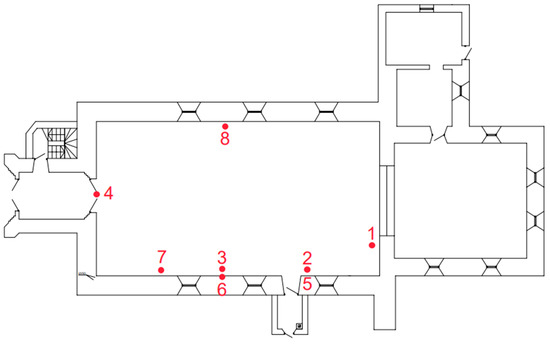
Figure 4.
Layout of the Krimulda Church with the installed measuring devices (where 1–8: numbers of measuring devices).
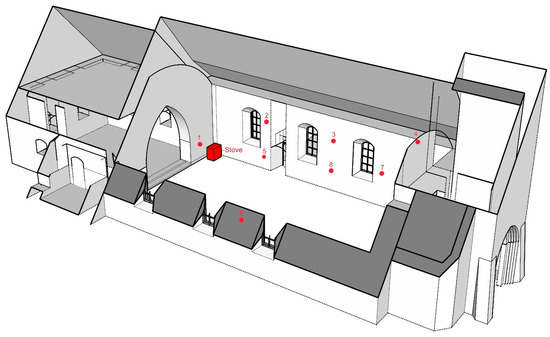
Figure 5.
3D image of the Krimulda Church with the installed measuring devices (where 1–8: numbers of measuring devices).
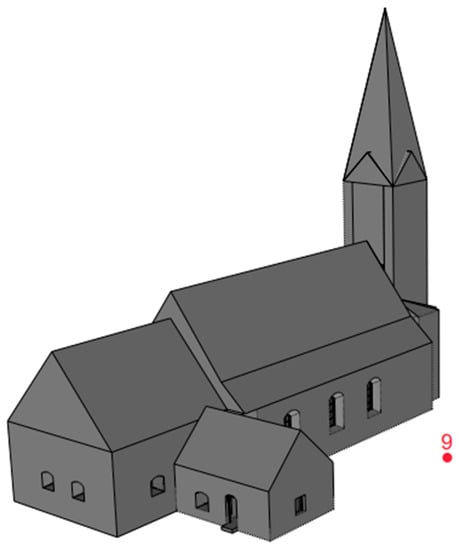
Figure 6.
3D image of the Krimulda Church with 9: the measuring device installed outdoors.
On the basis of the measured data, the theoretical surface temperature θsi, of walls and ceiling is calculated by means of the following formula:
where θi—the actual temperature of indoor air, C°; θe—the actual temperature of outside air, C°; U—heat penetration rate in the building envelope, W/(m2K); Rsi—heat transfer of the thermal resistance convection, m2K/W [22].
During periods of church heating, thermal images were taken with a thermal camera, the FLIR Lepton 2.5, 80 × 60, 50° (pixel size—17~μm; radiometric accuracy: high gain 5%; low gain 10%).
3.2. The Influence of Outdoor Air Humidity on the Indoor Microclimate
Microclimate measurements were carried out simultaneously from 7 July 2022 in four different churches:
- From 7 July 2022 to 24 April 2023 and from 10 January 2022 to 24 April 2022, microclimate measurements were taken in the Krimulda Church with exterior masonry walls and both brick and wooden vaulted ceilings. The Krimulda Church is a popular tourist attraction in Latvia, welcoming visitors 24/7 throughout the year. This accessibility provides a comprehensive understanding of how outdoor air humidity impacts the indoor microclimate. The Krimulda Church is situated in rural territory, in the middle part of Latvia, 34.45 km away from the border of the capital of Latvia, Riga, horizontally to the east. The parish hall’s area is 315.51 m2 and the volume is 3313 m3.
Temperature and relative humidity were measured with HOBO MX Temp/RH/Light/Ext-Temp Kit measuring instruments at 30-min intervals, with measuring accuracy of ±2.5% for relative humidity and ±0.2 °C for temperature.
Four HOBO MX1104 Temp/RH/Light/Ext-Temp Kit measuring devices were installed inside the Krimulda Church. The locations are shown in Table 1 and Figure 4, Figure 5 and Figure 6.
On the basis of air temperature and relative humidity measurements, the partial pressure of water vapour in moist air pw (kPa) was calculated:
where T—air temperature (C°), e—Euler’s number [23], and RH—relative humidity (%).
The air humidity ratio W (g/kg) was calculated from the partial pressure pw:
where p—barometric pressure (kPa) [24].
Based on temperature and RH measurements, the difference between indoor and outdoor air absolute humidity was calculated, and the excess moisture ∆v (g/m3) was determined by the following equation:
where vi is the humidity by volume of indoor air (g/m3) and ve is the humidity by volume of outdoor air (g/m3) [22].
∆v = vi − ve
4. Results and Discussion
4.1. Temperature in the Krimulda Church
We can see from the overall temperature diagram in Figure 7 that the temperature peak was reached at Point No. 1. The peak temperature 45.9 °C at this point was reached on 2/4/2023 at 9:30 p.m. During all periods of elevated temperature, i.e., heating of the premises, the peak temperature was reached at this point, which retained a temperature difference between 1 °C and 3 °C during the periods with the lowest temperature fluctuation (Figure 6). The next highest temperature, 17.416 °C, in this period was reached at Point No. 2, which was 28.478 °C lower, and this degree of difference between these points remained during all temperature fluctuation peak periods. In Figure 7, is a diagram showing that the lowest short-term (48 h) temperature fluctuations in the outdoor air did not affect the lowest indoor air temperatures of that period. However, in the long term (more than 10 days), as the average outdoor air temperature rises or falls, the lowest temperature of the indoor air during the same period fell or rose depending on the outdoor temperature (Figure 7).
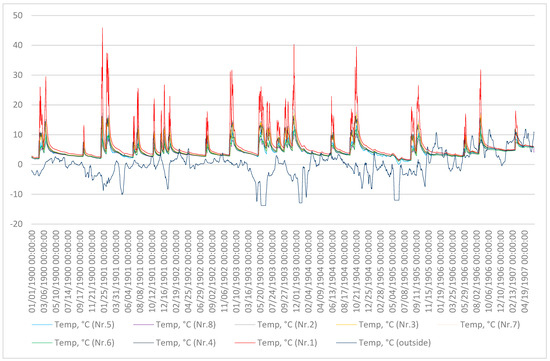
Figure 7.
Temperatures in the Krimulda Church.
The largest temperature fluctuations between the measured points were observed in all periods of temperature elevation, as seen in Figure 7; therefore, we will look more closely at the period with the highest temperatures, which were reached at point No. 1 between 4 February 2023 and 8 February 2023, but without data on Point No. 1 in Figure 8. Point No. 1 was located nearest to the heating stove, and it had the greatest heat radiation influence, which can also be observed in the thermal images in Figure 8 and Figure 9. From the temperature diagram in Figure 8, we can see that the temperature was similar in three points (points No. 2, No. 3, and No. 4), which were situated higher above the ground than other points, indicating a greater influence of thermal convection. The first highest temperature point during all elevated temperature periods was reached at Point No. 4, for example, on 2/4/2023 at 8 p.m., the temperature was 16.168 °C. This confirms a trend of warm air convection towards the tower. Meanwhile, the second temperature peak was reached at Point No. 2. At this point, at the same time, on 2/4/2023 at 8 p.m., the temperature was 13.206, 2.962 °C less than at Point No. 4, but after 2 h, on 2/4/2023 at 10 p.m., the temperature reached 17.416 °C, 1.248 °C more than at Point No. 4 two hours previously. Actually, the highest temperature was reached at Point No. 2, but with a delay of 2 h, and this or a smaller time delay could be observed during all temperature elevation periods. A similar temperature was also reached at Point No. 3 on 2/4/2023 at 8 p.m. when the temperature was 12.033 °C, while on 2/4/2023 at 10 p.m., the temperature exceeded 15.694 °C. This temperature difference trend remained during all episodes of occasional temperature elevation or heating of the premises.
The temperatures at other points, i.e., No. 5, No. 6, No. 7, No. 8, during these temperature elevation periods were lower by several degrees in comparison to previously described points. By looking at the previously mentioned period, shown in Figure 8, the highest temperature of these four points during the fluctuation periods was reached at Point No. 5 on 2/4/2023 at 10 p.m., when the air temperature was 12.158 °C. Thermal images taken during the same period, in Figure 9 and Figure 10, show the high impact of heat radiation at this point. The next temperature peak (Table 2) in the fluctuation period was located at Point No. 6 on 2/4/2023 at 10 p.m., where the air temperature was 9.4 °C. Meanwhile, at Point No. 7 on 2/4/2023 at 10 p.m., the air temperature was 6.9 °C, 2.5 °C lower than at point No. 6, but 30 min later, on 2/4/2023 at 10:30 p.m. at Point No. 7, the air temperature reached 8.1 °C, 1.3 °C lower than 3 min previously in point No. 7 but at the same time the temperature has not changed. This difference of 30 min in the temperature peak period between those two points was observed during all temperature elevation periods. Points No. 6 and No. 7 were situated at the same (±0.1 m) distance from the stove, but on different planes of the premises, and the differences of such temperature periods indicate varied heat radiation and convection influences on these points. Meanwhile, the lowest temperature was observed at Point No. 8. This point showed the temperature of the southern external wall. The temperatures at this point were 0.5 °C to 2 °C lower than the air temperature at Points No. 6 and No. 7 during all measurement periods. Throughout the measurement period, the lowest temperature of the wall surface, 1.5 °C, was reached on 3/11/2023 at 6 a.m., but the highest temperature, 10.5 °C, was reached on 3/5/2023 at 1 p.m. Meanwhile, during the entire measurement period, the average wall temperature was 4.0 °C, which indicates great heat accumulation by the masonry walls.
The calculated wall and ceiling surface temperatures for each air parameter measurement “On the balcony” are shown in a diagram in Figure 10, together with the dew point in each measurement. Based on the measurement and calculation results shown in Figure 11, it is evident that during the intense fluctuation periods, the temperatures of the wall and ceiling surfaces closely approached the dew point. However, none of the temperatures calculated for each point reached the dew point. These calculations did not take into consideration the thermal inertia of the building envelope (including the masonry of the external walls) during the fluctuation periods when the indoor air, with the help of the heating, was heated by 10 °C from 2 °C to 12 °C. The stone masonry external wall accumulated the heat from the previous period, and its temperature was 2 °C.

Table 2.
Measurement data for the temperature peak period.
Table 2.
Measurement data for the temperature peak period.
| Date Time, GMT+02:00 | Temp, °C (No 5) | Temp, °C (No 8) | Temp, °C (No 2) | Temp, °C (No 3) | Temp, °C (No 7) | Temp, °C (No 6) | Temp, °C (No 4) | Temp, °C (No 1) | Temp, °C (Outside) | |
|---|---|---|---|---|---|---|---|---|---|---|
| 2/4/2023 | 06:30:00 a.m. | 2.4 | 2.1 | 2.4 | 2.4 | 2.1 | 2.1 | 12.2 | 4.0 | −3.6 |
| 2/4/2023 | 07:00:00 a.m. | 5.5 | 2.9 | 8.7 | 7.8 | 2.1 | 3.7 | 11.9 | 26.9 | −3.5 |
| 2/4/2023 | 07:30:00 a.m. | 6.2 | 3.9 | 9.5 | 9.0 | 2.1 | 4.9 | 14.5 | 22.0 | −3.9 |
| 2/4/2023 | 08:00:00 a.m. | 8.5 | 5.1 | 13.2 | 12.0 | 3.7 | 6.4 | 16.2 | 32.6 | −4.2 |
| 2/4/2023 | 08:30:00 a.m. | 8.7 | 5.5 | 12.7 | 11.7 | 4.9 | 6.8 | 12.9 | 30.6 | −4.8 |
| 2/4/2023 | 09:00:00 a.m. | 7.9 | 5.7 | 12.5 | 11.7 | 6.4 | 6.9 | 10.5 | 28.0 | −5.8 |
| 2/4/2023 | 09:30:00 a.m. | 11.37 | 6.4 | 16.1 | 14.3 | 6.8 | 8.0 | 9.40 | 45.9 | −6 |
| 2/4/2023 | 10:00:00 a.m. | 12.2 | 7.6 | 17.4 | 15.7 | 6.9 | 9.4 | 8.8 | 39.8 | −6.5 |
| 2/4/2023 | 10:30:00 a.m. | 8.9 | 7.0 | 13.1 | 12.3 | 8.1 | 8.0 | 8.3 | 22.5 | −6.8 |
| 2/4/2023 | 11:00:00 a.m. | 7.4 | 6.2 | 10.4 | 10.0 | 9.4 | 6.8 | 7.8 | 16.6 | −7.5 |
| 2/4/2023 | 11:30:00 a.m. | 6.7 | 5.7 | 9.3 | 9.1 | 8.0 | 6.2 | 7.5 | 14.0 | −8.2 |
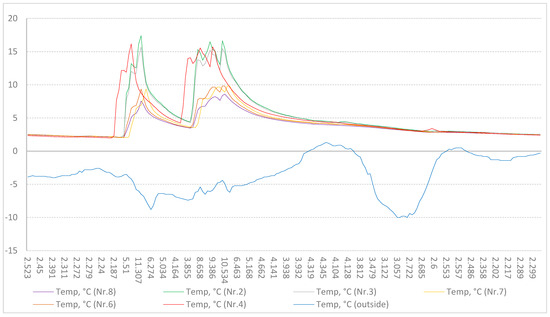
Figure 8.
Temperatures in the Krimulda Church between 04/02/2023 and 08/02/2023.
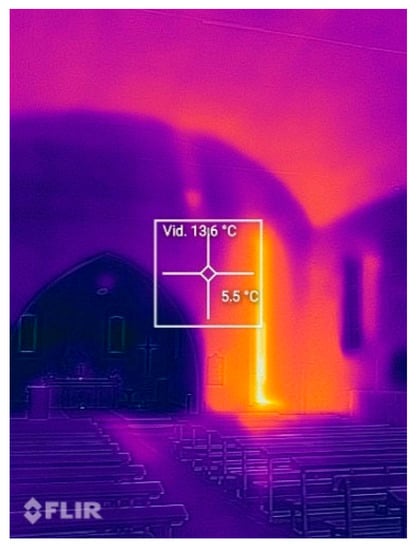
Figure 9.
Thermal image from the Krimulda Church on 04/02/2023 at 7:12 p.m.
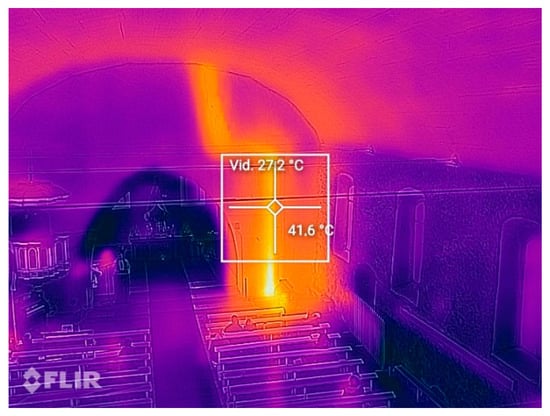
Figure 10.
Thermal image from the Krimulda Church on 05/02/2023 at 12:33 p.m.
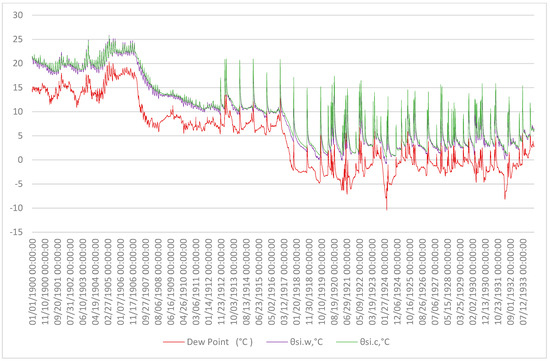
Figure 11.
The calculated temperatures in the wall and ceiling surface, as well as the dew point.
4.2. Moisture in the Krimulda Church
There is no permanent heating and ventilation system in the Krimulda Church. During the cold season, the indoor air of the church is heated with a steel wood-burning stove (~60 kW) prior to religious activities in the church. Fluctuations of indoor temperature and relative humidity in the Krimulda Church during all temperature elevation periods showed symmetrical differences among the points, as in Figure 12. This indicates that the direction of change in the air at all points was equal, but the air temperatures were different. The air temperatures differed at each of these points because there were different heat radiation and convection impacts on each of these points, as described above.
On the basis of measurement data at Point No. 4, “On the balcony”, we chose to further analyse the air moisture content within the premises, because this point was situated in the centre of the ceiling and, as concluded previously, the convection direction of the heated air in the premises moves towards this point, No. 4. On the basis of the measured relative humidity and temperature, we calculated the absolute humidity for each of those measurements, both for indoor air and outside air (Figure 13). When looking at the diagram in Figure 13, one can see that the highest indoor air humidity was wi = 14.33 g/kg on 8/15/2022 at 1 p.m., but the outside air humidity content at this moment was we = 12.6 g/kg, and the outside temperature was 27.6 °C. Meanwhile, the highest outside humidity content was we = 14.25 g/kg on 8/22/2022 at 8:30 p.m., while the outside air temperature was 20.6 °C and the internal air humidity ratio was wi = 12.84 g/kg. The diagram in Figure 13 shows that as the outside temperature fell, the average humidity ratio in the outdoor and indoor air also decreased.
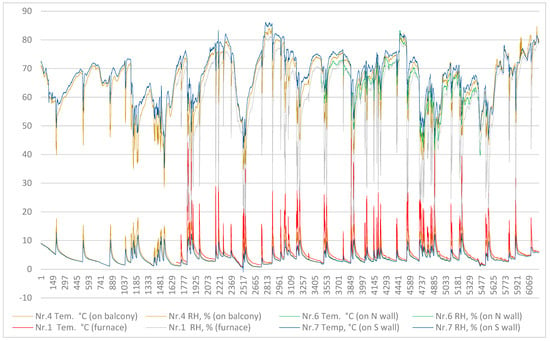
Figure 12.
RH and temperature in the Krimulda Church between 11/16/2022 and 25/03/2023.
In order to analyse the impact of visitors on the air humidity and short-term fluctuations, we will look at time periods with the maximum numbers of visitors, such as 12/24/2022 at 6 p.m., with up to 200 persons (0.63 pers/m2 or 0.06 pers/m3), and on 12/25/2022 at 12 p.m., with up to 90 visitors (Figure 14). From Figure 14, we can see that on 12/24/2022 after 8:30 a.m. (1.74 °C and vi = 3.08 g/kg), the air inside of the church heated up rapidly as the visitors to the church entered, with a maximum of three persons simultaneously. Before a large number of visitors gathered simultaneously in the building at 17:30, the indoor air heated up to 15.6 °C and the indoor humidity reached 5.18 g/kg. This increase in the room’s humidity ration when the room temperature became elevated indicates that moisture vapours were coming from all structures of the building, including the external masonry walls [3], slabs, and interior details. Meanwhile, at 6:30 p.m., when the number of visitors reached its peak, the indoor air temperature was 16.2 °C and vi = 6.1 g/kg. The simultaneous gathering of 200 persons in the church increased the air humidity ratio, both in terms of measurements by vi∆ = 1.08 g/kg and in terms of calculation from 1 to 2.5 g/kg if one visitor were to release 20 to 50 g/h of moisture [25]. These fluctuations in air parameters, when shown in the h-x diagram, allowed us to notice that, given the quantity of visitors and to prevent condensation risks, the minimum temperature must be 7 °C or the maximum humidity ratio—4.5 g/kg. The same tendency was observed the next day, on 12/25/2022 (Figure 14); when they began heating the indoor air, the air humidity ratio also increased by wi∆ = 2 g/kg, and at 12:30 p.m., when the number of visitors reached 87 persons, the air humidity ratio increased by another wi∆ = 0.5 g/kg and reached 4.8 g/kg.
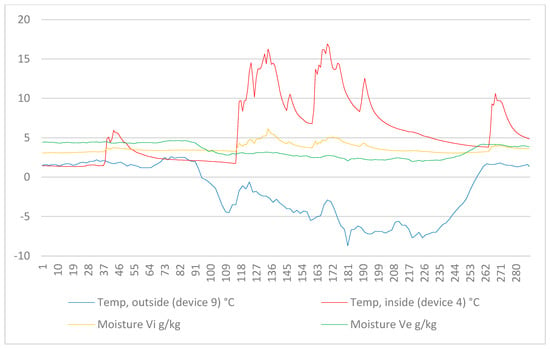
Figure 14.
Outdoor (device 9) and indoor moisture and temperature in the Krimulda Church on the balcony (device 4) between 12/22/2022 and 12/28/2022.
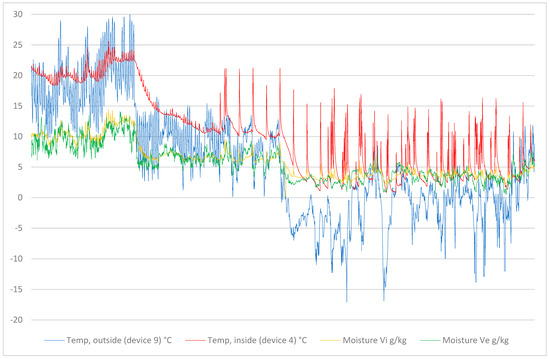
Figure 13.
Outdoor and indoor humidity and temperature in the Krimulda Church “on the balcony”.
According to the data measured at Point No. 4 “On the balcony”, the absolute excess moisture in indoor air and outdoor air, ∆v, was calculated, and the values are shown in the diagram in Figure 14. We can see from the diagram in Figure 15 that, according to the building’s standard [22] humidity classes, the cult buildings can be placed into the third humidity class, with an unknown load on the building where the upper threshold of the excess moisture was 6 g/m3. From this diagram in Figure 15, we can observe that the upper threshold of the excess moisture mostly reached and slightly exceeded 6 g/m3 when the outside temperature ranged between 27 °C and 30 °C. Taking a closer look at the time periods at which the upper threshold of the excess moisture, namely, 6 g/m3, was reached, one can conclude that these were short-term periods in August 2022 with high outside air temperature fluctuations and moisture concentration fluctuations related to precipitation during that period. Meanwhile, as concluded previously, the outside air humidity has a huge impact on the building as it has high indoor-air heat inertia; therefore, an excess of distance forms between the asymmetrical indoor and outside air values, which can cause additional short-term condensation risks.
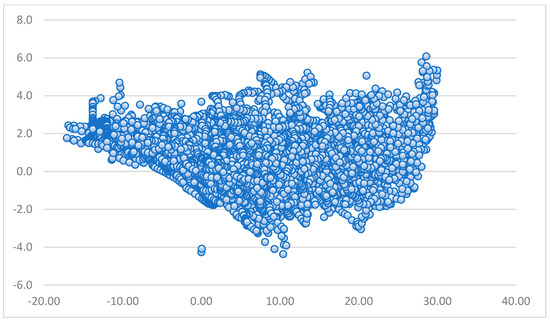
Figure 15.
Excess moisture in the Krimulda Church on the balcony.
5. Conclusions
For the heating strategy of a cult building, opting for a single heat source for the entire structure, as is the case with the Krimulda Church, can result in an uneven temperature distribution within the premises. Consequently, both the internal surface of its building envelope and the surfaces of various valuable items/interior details can reach the dew point temperature. We can conclude that irregular heating strategies cause significant temperature fluctuations in the indoor air and on the surfaces of the building (e.g., walls, ceiling, floor, interior items), leading to moisture condensation on various surfaces. Therefore, this heating strategy cannot be defined as a heating system providing a preserving microclimate. Further research should complement the analysis of the internal surface temperatures of stone masonry building envelope of under rapid fluctuations of internal air with computer-aided simulations.
The results of indoor air parameter measurements and calculations in the Krimulda Church indicate that the moisture vapours from the building structures (including the building envelope and interior details) constitute up to 2 g/kg.
During the summer period, the upper threshold of moisture difference, 6 g/m3, is reached in the Krimulda Church, and according to the standard [22], this is comparable to specialised high-humidity premises, such as catering premises. Therefore, we conclude that ventilating historical masonry buildings during the warm season is not recommended. If one is using this type of building on a regular basis during the warm season when the indoor humidity ratio increases, it is necessary to monitor the air parameters and to install dehumidifiers to reduce the moisture concentration indoors from 14.33 g/kg at least to 10 g/kg.
A significant influx of visitors during the heating season, along with the rapid increase in indoor temperatures resulting from a heating device, can lead to condensation risks. Potential condensation risks can be prevented either by ensuring a constant minimum indoor air temperature of 7 °C or by means of air-drying methods to reduce the indoor humidity level from 6.1 g/kg to 4.5 g/kg.
This type of research is ongoing in other churches of Latvia, including both masonry and wooden structures, that are equipped with permanent heating systems. Continued research will provide more complete thresholds of indoor air parameters in the microclimate for conservation purposes.
Author Contributions
Conceptualization, M.M., A.L. and A.B.; methodology, M.M., A.L. and A.B.; software, M.M. and A.B.; validation, M.M.; formal analysis, M.M. and A.L.; resources, M.M., A.L. and A.B.; data curation, M.M. and A.B.; writing—original draft, M.M.; writing—review & editing, M.M. and A.L.; visualization, K.T.; supervision, A.L. and A.B.; funding acquisition, A.B. All authors have read and agreed to the published version of the manuscript.
Funding
This work was supported by the European Social Fund within the Project No. 8.2.2.0/20/I/008 “Strengthening of Ph.D. students and academic personnel of Riga Technical University and BA School of Business and Finance in the strategic fields of specialization” of the Specific Objective 8.2.2 “To Strengthen Academic Staff of Higher Education Institutions in Strategic Specialization Areas” of the Operational Programme “Growth and Employment”.
Institutional Review Board Statement
Not applicable.
Informed Consent Statement
Not applicable.
Data Availability Statement
Not applicable.
Conflicts of Interest
The authors declare no conflict of interest.
References
- Metals, M.; Lesinskis, A.; Turauskis, K. Control of Indoor climate of Historical cult buildings. E3S Web Conf. 2021, 246, 01005. [Google Scholar] [CrossRef]
- LVS EN 15759-1; Conservation of Cultural Property—Indoor Climate—Part 1: Guidlines for Heating Churches, Chapels and Places of Worship. Latvian Standard: Riga, Latvia, 2012.
- Metals, M.; Palcikovskis, A.; Borodinecs, A.; Lesinskis, A. Typology of Latvian Churches and Preliminary Study on Indoor Air Temperature and Moisture Behavior. Buildings 2022, 12, 1396. [Google Scholar] [CrossRef]
- Hayati, A. Measurements and modeling of airing through porches of a historical church. Sci. Technol. Built Environ. 2018, 24, 270–280. [Google Scholar] [CrossRef]
- Muñoz González, C.; León Rodríguez, A.L.; Suárez Medina, R.; Ruiz Jaramillo, J. Effects of future climate change on the preservation of artworks, thermal comfort and energy consumption in historic buildings. Appl. Energy 2020, 276, 115483. [Google Scholar] [CrossRef]
- Vuerich, E.; Malaspina, F.; Barazutti, M.; Georgiadis, T.; Nardino, M. Indoor measurements of microclimate variables and ozone in the church of San Vincenzo (Monastery of Bassano Romano—Italy): A pilot study. Microchem. J. 2008, 88, 218–223. [Google Scholar] [CrossRef]
- Varas-Muriel, M.; Fort, R.; Martínez-Garrido, M.; Zornoza-Indart, A.; López-Arce, P. Fluctuations in the indoor environment in Spanish rural churches and their effects on heritage conservation: Hygro-thermal and CO2 conditions monitoring. Build. Environ. 2014, 82, 97–109. [Google Scholar] [CrossRef]
- Zemitis, J.; Borodinecs, A.; Geikins, A.; Kalamees, T.; Kuusk, K. Ventilation System Design in Three European Geo Cluster. Energy Procedia 2016, 96, 285–293. [Google Scholar] [CrossRef][Green Version]
- Sovetnikov, D.; Baranova, D.; Borodinecs, A.; Korniyenko, S. Technical problems in churches in different climatic conditions. Constr. Unique Build. Struct. 2018, 64, 20–35. [Google Scholar] [CrossRef]
- Napp, M.; Kalamees, T. Energy use and indoor climate of conservation heating, dehumidification and adaptive ventilation for the climate control of a mediaeval church in a cold climate. Energy Build. 2015, 108, 61–71. [Google Scholar] [CrossRef]
- Mihincau, D.C.; Ilies, D.C.; Koroleva, Y.; Herman, G.V. The study of indoor microclimate on wooden churches to be included among Oradea’s representative sights. GeoJ. Tour. Geosites 2019, 26, 737–750. [Google Scholar] [CrossRef]
- Samek, L.; De Maeyer-Worobiec, A.; Spolnik, Z.; Bencs, L.; Kontozova, V.; Bratasz, Ł.; Kozłowski, R.; Van Grieken, R. The impact of electric overhead radiant heating on the indoor environment of historic churches. J. Cult. Herit. 2007, 8, 361–369. [Google Scholar] [CrossRef]
- Schellen, H.L.; Huijbregts, Z.; van Schijndel, A.W.M.; Kramer, R.P. The use of COMSOL to explore flooding and rising water problems related to heritage. In Proceedings of the 2015 Comsol Conference in Grenoble, Grenoble, Switzerland, 14–16 October 2015. [Google Scholar]
- Vella, R.C.; Martinez, F.J.R.; Yousif, C.; Gatt, D. A study of thermal comfort in naturally ventilated churches in a Mediterranean climate. Energy Build. 2020, 213, 109843. [Google Scholar] [CrossRef]
- Hnilica, O.; Bichlmair, S.; Plášek, J. Indoor climate in Jesuit church of holy name of Jesus in Telc. E3S Web Conf. 2019, 111, 03056. [Google Scholar] [CrossRef]
- Iñigo, A.; García-Talegón, J.; Vicente-Palacios, V.; Vicente-Tavera, S. Canonical Biplot as a tool to detect microclimates in the inner and outer parts of El Salvador Church in Seville, Spain. Measurement 2019, 136, 745–760. [Google Scholar] [CrossRef]
- Anaf, W.; Schalm, O. Climatic quality evaluation by peak analysis and segregation of low-, mid-, and high-frequency fluctuations, applied on a historic chapel. Build. Environ. 2019, 148, 286–293. [Google Scholar] [CrossRef]
- De Vita, M.; Rotilio, M.; Marchionni, C.; De Berardinis, P. Architectural Heritage Indoor Comfort after Retrofit Works: The Case Study of S. Vito Church in L’Aquila, Italy. Sustainability 2023, 15, 8239. [Google Scholar] [CrossRef]
- Poljak, M.; Ponechal, R. Microclimatic Monitoring—The Beginning of Saving Historical Sacral Buildings in Europe. Energies 2023, 16, 1156. [Google Scholar] [CrossRef]
- Bogdan, A.; Chambre, D.; Copolovici, D.M.; Bungau, T.; Bungau, C.C.; Copolovici, L. Heritage Building Preservation in the Process of Sustainable Urban Development: The Case of Brasov Medieval City, Romania. Sustainability 2022, 14, 6959. [Google Scholar] [CrossRef]
- Sola-Caraballo, J.; Rincón-Calderón, J.M.; Rivera-Gómez, C.; López-Martínez, J.A.; Galán-Marín, C. On-Site Risk Assessment Methodology of Historic Timber Structures: The Case Study of Santa Cruz Church. Buildings 2022, 12, 935. [Google Scholar] [CrossRef]
- EN ISO 13788:2013; Hygrothermal Performance of Building Components and Building Elements—Internal Surface Temperature to Avoid Critical Surface Humidity and Interstitial Condensation—Calculation Methods. ISO: Geneva, Switzerland, 2020.
- Alduchov, O.A.; Eskridge, R.E. Improved Magnus’ from Aproximation of Saturation Vapor Pressure. 1997. Available online: http://www.osti.gov/servlets/purl/548871-PjpxAP/webviewable/ (accessed on 14 August 2023).
- ASHRAE. 2021 ASHRAE® Handbook: Fundamentals; ASHRAE: Peachtree Corners, GA, USA, 2021. [Google Scholar]
- Zemītis, J. Analysis and Prediction Methods of Indoor Air Quality. 2015, pp. 7–8. Available online: https://www.rtu.lv/writable/public_files/Jurga_Zemisa_darba_kopsavilkums.pdf (accessed on 14 August 2023).
Disclaimer/Publisher’s Note: The statements, opinions and data contained in all publications are solely those of the individual author(s) and contributor(s) and not of MDPI and/or the editor(s). MDPI and/or the editor(s) disclaim responsibility for any injury to people or property resulting from any ideas, methods, instructions or products referred to in the content. |
© 2023 by the authors. Licensee MDPI, Basel, Switzerland. This article is an open access article distributed under the terms and conditions of the Creative Commons Attribution (CC BY) license (https://creativecommons.org/licenses/by/4.0/).